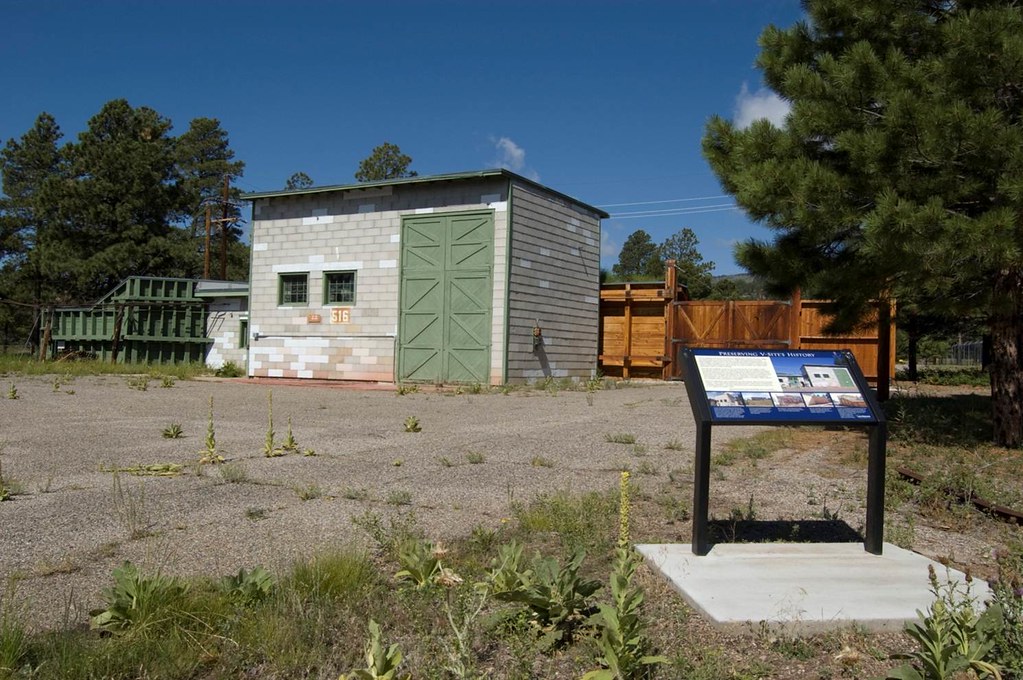
Exceptionally significant historic buildings and structures
Associated with World War II and the Cold War, 35 exceptionally significant historic buildings and structures at LANL are candidates for long-term retention and management.
Seventeen properties supported the wartime Manhattan Project and are potentially contributing properties to the existing Los Alamos Scientific Laboratory (LASL) National Historic Landmark (NHL) District.
These 17 properties may someday be part of a Los Alamos unit of the proposed Manhattan Project National Historical Park.
LANL properties included in the revised Los Alamos Scientific Laboratory National Historic Landmark District
Properties that represent the effort to design and develop the uranium gun bomb, "Little Boy":
- TA-08-0001 Laboratory and Shop
- TA-08-0002 Shop and Storage
- TA-08-0003 Laboratory
- TA-08-0172 Portable Guard Shack
Properties that represent the effort to design and develop an implosion bomb, "Fat Man":
- Assembly of the implosion device, the Gadget, tested at Trinity Site
- TA-16-0058 High Explosives (HE) Magazine
- TA-16-0516 V-Site Assembly Building
- TA-16-0517 V-Site Building
Development and testing of the first "Fat Man" bomb and related implosion and criticality research:
- TA-06-0037 Concrete Bowl
- TA-11-0001 Control Building
- TA-11-0002 Betatron Building
- TA-11-0003 Cloud Chamber Building
- TA-12-0004 Hexagonal Firing Pit
- TA-14-0006 Shop/Darkroom Building
- TA-18-0001 Slotin Building
- TA-18-0002 Battleship/Control Building
- TA-18-0029 Pond Cabin
- TA-22-0001 Assembly Building/Quonset Hut
Los Alamos is one of three areas "identified as containing exceptionally significant historical properties that, when taken together, represent one of the most important events of the twentieth century."
The National Park Service National Historical Park Study
In 2004, Congressional legislation sponsored by Representative Doc Hastings and Senator Jeff Bingaman directed the National Park Service to examine historical areas associated with the Manhattan Project and make recommendations concerning the possibility of establishing a new national park.
The study’s Finding of No Significant Impact (FONSI), issued in November 2010, contained a Revised Alternative E, with Los Alamos, Hanford, and Oak Ridge each listed as park units. The three areas were identified as containing exceptionally significant historical properties that, when taken together, represent one of the most important events of the twentieth century.
The park would be a Department of Interior (DOI) and Department of Energy (DOE) partnership with continued DOE ownership and management of its historic properties. The National Park Service would provide interpretation, education, and technical preservation assistance for properties at LANL.
Potential Los Alamos park properties include buildings in the town of Los Alamos associated with the Manhattan Project, but built as part of the Los Alamos Ranch School. These include the “Bathtub Row” houses built for the school’s instructors and for other school functions, the Ranch School’s former powerhouse, and Fuller Lodge (now the town’s most important community space). Several examples of government wartime properties still exist in the townsite area, including a former dormitory building and a former cafeteria (now a community performing arts space).
The FONSI also listed six areas (nine individual properties total) located at LANL and built by the U.S. Army’s Manhattan Engineer District. These include buildings and structures associated with the design and assembly of the “Gadget” (tested at Trinity Site), the Little Boy weapon (the gun-assembled device detonated over Hiroshima) and the Fat Man weapon (the implosion device detonated over Nagasaki), as well as an experimental plutonium recovery structure and two buildings that supported wartime weapons research. The planned revision of the LASL NHL District was also cited in the FONSI, and the additional Manhattan Project-era buildings at LANL under consideration in the draft nomination were also mentioned, although not by name. These include buildings at TA-08, TA-11, TA-12, TA-14, TA-16, and TA-18.


